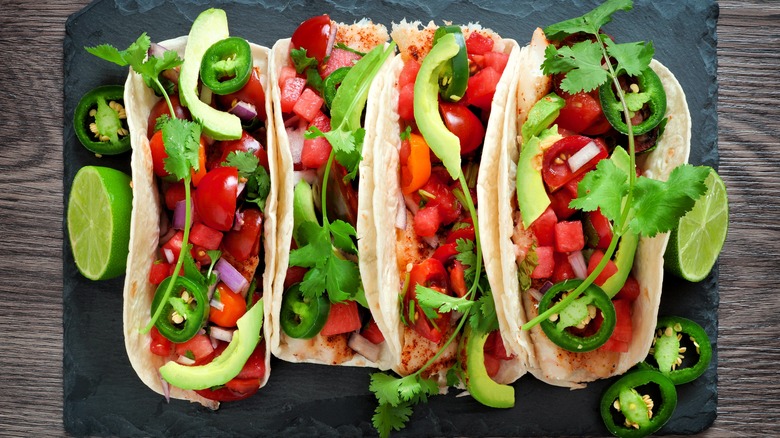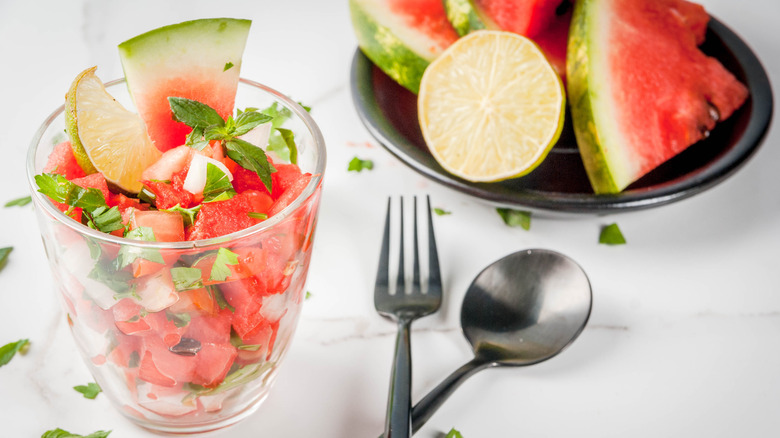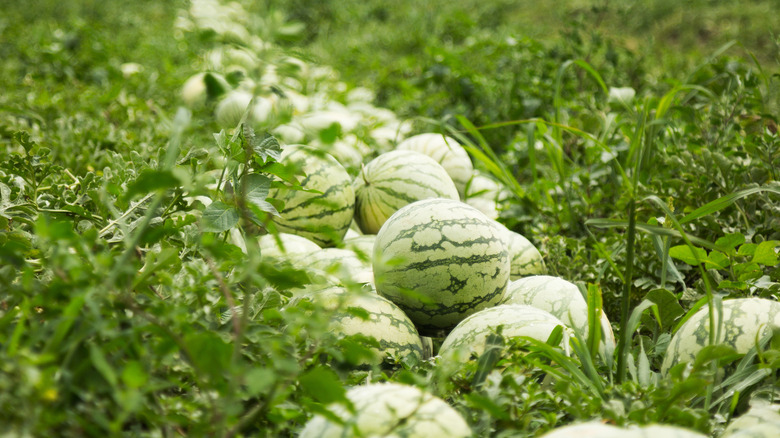Swap Watermelon Into Your Favorite Tomato Salsa And Thank Us Later
If you look closely at some modern chunky salsa dips, especially in warm summer months, you may notice those brilliantly hued, diced red squares are not actually tomatoes. Traditionally, a salsa recipe centers on tomatoes of all varieties, from Roma to early girl, Campari, better boy, Brandywine, beefsteak, super sweets, and dozens more, including heirloom or specialties versions such as the green zebra tomato. But making and eating good food means opening your mind and kitchen to innovative experimentation, right? Welcome to watermelon salsa, and yes, you can thank us later.
Watermelon obviously takes center stage in this version of salsa, but like tomato-based ones, it doesn't nestle alone inside the container. It's typically joined by a parade of fresh ingredients ranging from additional fruits to chopped vegetables, fresh-squeezed citrus juice, aromatic herbs, and zesty spices. You'll rarely find watermelon salsa ready-to-go from a supermarket since the fragile nature of watermelon flesh has a shorter shelf life than tomatoes. Luckily, it's easy to make at home where it'll be super fresh and ready for dipping, spooning, or just-plain digging in.
What's in that juicy watermelon salsa
First off, it's best to acknowledge that watermelon salsa will be sweeter than its tomato-based counterpart. That's why you mix and mingle contrasting flavors to achieve the perfect balance. In many ways, salsa as a fan-favorite foodie dip is similar to the same-name salsa dance, bringing diverse international elements into the fun. You'll often find cilantro – an herb prominent in Mexican, Asian, and Middle Eastern cooking — in watermelon salsa, which adds a tinge of bright, peppery, citrusy flavor to most tastebuds.
Some recipes call for basil leaves instead of cilantro, imparting varying tones depending on the basil type, which can carry hints of mint, pepper, anise, or even licorice. Many recipes also include complementary or contrasting fruits such as mangoes, strawberries, or kiwis. Other popular add-ins for watermelon salsa are cucumbers, bell peppers, ground black pepper, or garlic salt. Crucially, a splash of fresh lime juice finishes things off, preferably with grated lime zest. Consider making small tasting cups with cubed watermelon and tossing in varying ingredients until you reach that aha! moment.
Depending on what you're serving with the salsa, you may want to keep things relatively simple, just tossing the melon with cilantro, sweet red onions, and lime juice, with diced jalapeños for a punchy kick. If you like sensory storms straight-on, just take a fork and dive right in. Alternatively, scoop it up with crunchy tortilla chips or add chicken and wrap it in a warm flour tortilla.
Watermelon ripeness is key in watermelon salsa
We all know the feeling — laboriously cutting, slicing, and dicing a hefty fresh watermelon –– only to find that its flesh is limp and mealy rather than crunchy and juicy. That's likely because you've unknowingly chosen an overripe melon. For watermelon salsa, this could be a dealbreaker, at least as far as texture is concerned.
Choosing a watermelon is nuanced and debatable, depending on who's doing the talking. But generally, you get better chances of a perfectly ripe watermelon when following basic "watermelon dos." That is, do look for the yellowish field spot indicating that it matured naturally in the field and wasn't picked prematurely. Do pick it up and check for heaviness, as that typically indicates more water and more juicy sweetness. And do look for dark, dull outer skin to indicate proper ripeness.
If you happen to split open an overly ripe watermelon, with no time for an emergency replacement rush to the grocery store, you do have one good option. Gazpacho, a close cousin to salsa, also holds up well as a spicy watermelon dish, and it typically uses similar ingredients. The end result, which comes from pulverizing in a food processor, requires a bowl and a spoon since gazpacho is typically served as a refreshing cold soup. Add a touch of creaminess with sliced avocados, or multiply the fruitiness with some blueberries or blackberries.



